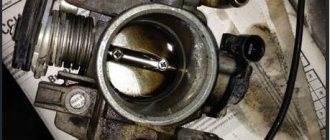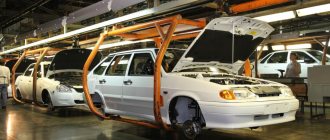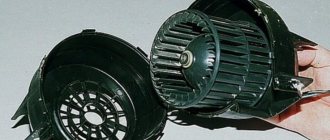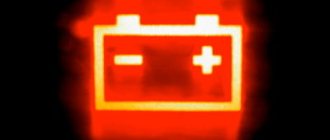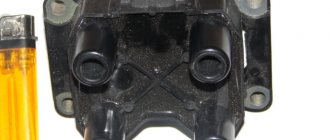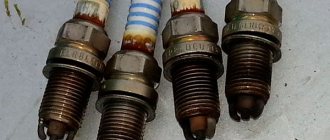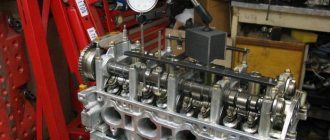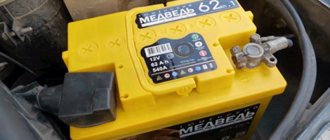Owners of domestic cars often complain that the VAZ 2114 stalls at idle (injector). The problem does not appear immediately; often even the engine gives signals to the owner, for example:
- Noticeable increase in fuel consumption;
- At low speeds the car jerks;
- The engine speed fluctuates noticeably.
If you don't pay attention to this, you can end up with a lot of problems in the future. Let's look at the reasons for the drop in idle speed.
The IAC has failed
One of the common problems why the engine jerks at idle is failure of the IAC. The sensor is a device that helps control engine speed by allowing a small amount of air into the engine. Which, in turn, detects the mass air flow sensor and gives a signal to the engine ECU, which is responsible for fuel supply.
If the sensor fails, you may notice floating speed at idle, and while driving, the engine may stall when the gear is turned off. If you observe such symptoms in engine operation, removing the sensor and cleaning it will help, but it is best to replace it with a new one and forget about this problem.
How is everything going?
So, one “fine” day you get into your car and start it. Starting the engine is easy, you do not observe any malfunctions in its operation. However, as soon as you take your foot off the gas pedal, a certain instability appears (engine speed drops, while the idle speed sensor reflects the presence of their nominal amount) and after some time the car stalls and stops.
Of course, this may be an isolated case, and then there is no need to panic. But, as a rule, after some time this problem arises again and has to be solved.
Air leak
If the idle speed of a VAZ 2114 drops, then you should look at the engine intake system. Perhaps some pipe or intake manifold has burst, because of this, excess air enters the engine outside the MAF sensor, as a result of which the mixture in the engine becomes leaner. To diagnose the problem, take a can of carburetor cleaner or “quick start” and spray it on the pipes and the manifold itself in hard-to-reach places and connections. If you notice that engine performance temporarily improves and is restored, then the problem area has been found.
Useful : TOP 10 reasons why engine thrust may be lost
Common problems on all engines at idle
As the old saying goes, a motor won't run if there's nothing to ignite, or nothing to ignite. For gasoline engines with quantitative control of the mode, the idle conditions are the most severe. The throttle valve is closed.
We recommend: DIY methods for removing bumper scratches
The volume of air entering the cylinder is minimal, and so is the pressure - just enough fuel mixture is supplied to allow the engine to rotate.
The oscillogram of the pressure in the cylinder, even at slightly increased speeds, gives us a pressure peak slightly above 5 bar. And this, mind you, is a serviceable engine, whose compression when hot is 13 bar. Now imagine what the pressure will be when it’s cold, when the pressure loss through the piston rings is greater. Therefore, since ancient times, almost the first thing people look at when a car stalls at idle is the condition of the engine. Measuring compression, even with a crude mechanical pressure gauge, accurately determines how worn the cylinder-piston group or valves are. In highly accelerated engines, wear is also added to by the possibility of errors when setting the marks of the gas distribution mechanism. Where the GAZ-69 works quietly when the camshaft gear is shifted by a tooth, a more modern engine is no longer able to hold idle.
Excessive pressure losses in a worn-out engine during the compression stroke can only be compensated by increasing the air supply. You have to maintain the speed with the gas pedal, but starting the engine will be a whole ritual, since at starting speed the peak compression pressure is even lower than at idle.
For a diesel engine, compression is even more important. By heating the air, which is compressed in the cylinder, the fuel injected by the injector is ignited. At the same time, the regulation of the regime in diesel engines is qualitative, not quantitative: as much air enters the cylinder as it can draw in, only the volume of injected fuel changes. But due to the fact that at idle the compression stroke time is the greatest, with loss of tightness (wear of rings, burnout of valves, losses through the cylinder head gasket), the highest loss of compression pressure will be at idle, and a diesel engine operating normally at high speeds, when released The gas pedal may also start to stall.
We must not forget about the quality of the fuel itself: it often happens that problems begin after refueling. Moreover, the emergence of network gas stations did not reduce the scale of the problems; rather, on the contrary: if previously it was possible to protect yourself from an outright “leftist” without stopping at openly suspicious gas stations (for example, in his own city, the author quickly learned where to refuel, where not, and where – only if it is urgently needed), but now gas stations of large chain companies regularly supply car repair shops with cars that stubbornly refuse to work: it is enough to mistakenly splash diesel fuel into the gas tank instead of the “ninety-two”, and even the unpretentious UAZ-469 will begin to work intermittently.
Dirty throttle valve and pipes
From time to time the throttle valve becomes clogged, for example if the air filter is already in poor condition. Then it’s worth removing all the pipes from the throttle, checking them for permeability and blowing them out. It definitely won't be redundant.
Next, disconnect the throttle cable and wires and remove the throttle. The cleaner can be found at any auto store. In case of heavy contamination, take a clean container and soak the throttle valve in gasoline in it for some time. Don't be afraid to blow out absolutely everything, as the throttle has narrow channels that can also clog.
The relationship between the engine and car subsystems: theory
To understand the theory of the occurrence of such a situation, it is necessary to imagine how exactly the power unit of a car functions. It is worth understanding that the operation of the internal combustion engine in any mode depends on factors such as:
- fuel assembly composition;
- serviceability of the fuel injection pump and pump;
- UOZA or UOVT (for diesel engines);
- compression;
- state of spark-forming elements;
- timing belt work and much more.
If disturbances occur in one of the car engine systems, this will automatically lead to a change in the operating mode. For example, if compression decreases, the proportion of gases appearing during the process of chemical decomposition will not participate in the overall work, but will only interfere. As a result, the pressure force on the piston will decrease, the speed will drop, and the engine will stall.
The same can be said about the lubrication system and generator. If the gene voltage drops for any reason and the lubrication efficiency decreases, the engine speed drops below the required level. And vice versa, if the speed goes down, the voltage decreases. All this leads to an increase in the amount of energy required to rotate the crank.
If engine operation stabilizes after pressing the accelerator pedal, whether in idle mode or on the road, it means that there is a slight malfunction of one of the engine systems (if an injector) or a malfunction of the idle system (if a carburetor). If this does not help, the engine should be taken for professional diagnostics.
TPS is out of order
The throttle position sensor is another suspect. The symptoms are similar to IAC, except that when moving away smoothly the car will do so jerkily. The sensor is also located on the throttle in the area where the throttle cable is connected.
The test can be done using a multimeter. If TPS is installed on the car, then open the throttle and watch the tester readings, they should change smoothly. If removed, then use a screwdriver and also look at the readings.
Useful : 8 reasons why the VAZ 2114 does not start when hot
Reasons for stopping the engine while driving
There are situations when the engine suddenly stalls while driving. Why does the car stall when driving?
- The car runs on low quality fuel. This is usually the very first thought that comes to the driver after stopping the engine. You can be completely confident in the correctness of the diagnosis only if you turn off the engine immediately after refueling. To fix the problem, you need to drain the fuel and install a new fuel filter.
- Faulty spark plugs. It is a very common cause. In such a situation, you should unscrew the spark plugs, inspect them, check their condition and decide whether replacement is necessary.
- Problems with the fuel filter. A clogged filter can lead to interruptions in fuel supply. While driving, you press the gas pedal and the engine will stop running. The problem is solved by replacing the fuel filter.
- Dirty air filter. If this element is severely clogged, air will flow poorly, which will lead to an over-enrichment of the fuel-air mixture and the spark plugs will flood. Also, from a lack of air, the engine will “choke.” The car's power will drop significantly, combustion of the mixture in the cylinders will become impossible and the engine will stall. In this situation, it will be necessary to replace the air filter.
- Problems with the fuel pump. If the fuel pump is faulty, the engine may not start at all or may stall while driving. You should carefully check the fuel pump, replace it or perform inexpensive repairs.
- . Severe oxidation of the terminals and poor contact cause the engine to stop.
It is necessary to check the terminals and clean them well of unnecessary formations. If this does not help, you will have to completely replace the battery. - Problems with the generator. If the engine stalls while driving and does not start, then, most likely, the problem is in this device. A broken generator does not create the required charge, as a result of which the entire electrical network of the car is powered only by the battery, which cannot work on its own for a long time. The driver continues to use the car, unaware that only the battery is being used. As a result, the battery is completely discharged. This situation can be solved by repairing the generator and charging the battery.
- Faulty sensor and electronics. Most often found in expensive cars with rich equipment.
In this case, it is best to turn to real specialists and professionals in their field, since solving the problem yourself can lead to a pointless waste of money and time.
Type of spark plugs for different uses
Fuel pump strainer is clogged
Considering the quality of fuel supplied to our market, you can often encounter a similar problem. If you have checked everything listed above, but still have not figured out the problem, it is better to immediately go to the nearest auto parts store and purchase a new mesh there. The issue price is about 70 rubles.
Then, under the rear seats, we find the hatch and unscrew it, gaining access to the gas tank. We disconnect all the tubes and remove the fuel pump mount and remove the entire mechanism from the tank. A mesh will be attached to the supply to the fuel pump, remove it and install a new one. Afterwards we collect everything back into the gas tank.
Preventative work.
Of course, the problem of a car stopping at idle is not very serious and, as a rule, can be fixed quite easily. However, one way or another, this is an unnecessary inconvenience on the road, as well as an increased risk of accidents, so it is better not to let everything go wrong, but to regularly carry out preventive maintenance, which in this case consists of careful care of the car and its components, regular cleaning parts that are most susceptible to various types of contamination, as well as strict adherence to the recommendations given in the operating instructions for your vehicle.
Most experienced drivers are familiar with the situation when the power unit stalls at idle or functions unstable when driving. It is important to know where to look and be able to tweak what is required to normalize the situation. Unfortunately, many people get lost in such situations and don’t know what to do.
DMRV has failed
What to do if the VAZ 2114 stalls at idle. The mass air flow sensor may fail. It controls the flow entering the engine, so if its operation is disrupted, the fuel mixture will be rich. The mass air flow sensor can be checked in three ways.
- With the engine running, disconnect the terminal and see if its operation changes.
- Perform diagnostics using the screen on the dashboard. You will see code P0113, which indicates a problem with air entering the combustion chamber. If the sensor fails completely, problems with idle speed may appear, but it will be diagnosed as working.
- Multimeter. Make sure the engine is stopped and the ignition is turned off. To diagnose, we need to measure the voltage on the sensor using two wires: green and yellow. Normal values are considered to be from 0.999V to 1.02V. If higher or lower, the sensor is faulty.
Try to always monitor and listen to the engine. If you notice that the engine on a VAZ 2114 does not pick up speed when cold, it is better to immediately begin troubleshooting the problem. Also, do not wait until the problem appears that the engine does not hold speed at idle - pay attention to the car, and it will not cause you unnecessary trouble.
Problems with carburetor engines
The idle system in the carburetor is the most sensitive to contamination. Therefore, if a carburetor engine stalls at idle, it is worth blowing out the jets and channels of the idle system, and on cars with electronic forced idle control, also check the operation of the economizer solenoid valve. On Solex carburetors (VAZ 2108-2109), the idle fuel nozzle is mounted on the solenoid valve rod, and if there is no voltage on the valve, it is closed. To make sure that the valve is at fault, on these carburetors it is enough to unscrew it slightly to remove the pressure of the jet against the body and allow fuel to flow past the blocked jet. Has the idle speed stabilized? This means that either the EPHH unit does not supply voltage to the valve (which is checked with a light bulb or a tester), or the valve itself is inoperative.
There are not many reasons why a valve control unit may not supply voltage to it. In addition to the malfunction of the unit itself, this is a loss of power at pin 4, a broken connection with the ignition coil (the EPHH unit stops “seeing” engine speed), and the absence of “ground” at the carburetor end (pin 5) when the gas pedal is released.
Note that a common problem with carburetors is the rigid connection between the composition of the air-fuel mixture from the vacuum and the fuel level in the float chamber. If any of these parameters change, the composition of the mixture will also “float away”. It will go beyond the limits of normal ignition - if the car does not idle until it warms up, then the mixture is over-lean, but if the car stalls when hot, then over-richness is already occurring.
A change in vacuum at idle is a consequence of air leaks through the vacuum lines (for a VAZ, this is often a vacuum brake booster or a vacuum distributor corrector) or a violation of the tightness of the joint between the carburetor and the manifold. Here, Solexes have a long-known disease with warping of the mating plane of the body; Ozones show themselves better in this regard.
The ignition on carburetor cars in the vast majority of cases is distributor-type, with the exception of two-cylinder engines, where it is enough to use a two-terminal coil without spark distribution. If the motor stalls and does not start, then the problem is hidden until the spark is emitted - look at the breaker contacts, the central high-voltage wire, the carbon contact connecting the cover and the slider.
We recommend: We treat the plastic interior from scratches. Proven methods!
Problems with spark plugs are common to both carburetor and injection engines. This includes natural wear, which under normal conditions proceeds evenly; sooner or later all the spark plugs in the set will begin to work intermittently, and carbon deposits due to low-quality fuel or a violation of the mixture composition (over-enrichment, carbon black carbon deposits damage the spark plugs). Iron-containing additives (the notorious ferrocene) can “kill” spark plugs in one unsuccessful refill. So you should immediately pay attention to the candles, especially if access to them is not difficult.
Why does the engine stall after starting?
- Sometimes it happens that the engine works correctly at first, but after a while it stalls again. Prolonged popping sounds in the carburetor that occur during startup indicate a lack of fuel supplied directly to the carburetor chamber. In such a situation, it is necessary to check the condition of the fuel pump and eliminate the detected cause of the malfunction. If the fuel pump is working correctly, then you should look at how well the carburetor air valve is installed.
- An incorrectly configured carburetor damper drive will lead to an increase in the amount of fuel supplied. The engine will stall because the fuel mixture is too rich.
- One of the reasons for the malfunction is an increase in the fuel level inside the float chamber. Malfunctions can be caused by a violation of the fuel level adjustment system, severe damage to the floats, regular contact of the float with the walls of the internal chamber, or the entry of a special mechanical impurity under the needle valves. As a result of these breakdowns, fuel consumption increases significantly. In this situation, it is best to go to a specialized automobile workshop, since it is there that they will be able to carry out proper carburetor repairs.
The operation of the injection system has always been a weak point of VAZ cars. Low-quality gasoline, counterfeit consumables, inept repairs done by yourself or unprofessional service - the car stalls for any of these reasons.
On older cars of the Samara-1 generation, a similar problem was solved by adjusting the carburetor and ignition. Less commonly, replacing the fuel pump. The electronic injector of the VAZ 2114 is many times more reliable than a carburetor; it starts and works in any weather without causing any trouble.
But if the injection machine still stalls, there can be many reasons for this.
Reasons for "blondes"
Sometimes poor performance of the injection system is simply due to inattention to the condition of the car and untimely maintenance.
1. Filters are clogged.
Replacing air and fuel filters is a mandatory part of car maintenance for experienced car owners. The average service life of filters on a VAZ is 30,000 km. The actual value depends on the quality of the fuel and the filter itself, and operating conditions. If the car has traveled more than 100 thousand kilometers, it is advisable to change the filters more often, every 10-15 thousand (or once a year). During this mileage, dirt inevitably accumulates in the system.
If your car stalls in neutral or immediately after starting the engine, start by inspecting the filters.
2. Lack of gasoline.
The critical fuel level cannot be allowed. Dirt may get into the fuel line and settle at the bottom of the tank. If the gauge has reached a critical level (or does not work), the car has just been driving, and after stopping it does not start or starts and stalls, you may need to add fuel.
Firstly, the accuracy of the FLS on the VAZ is not ideal. Secondly, if you stop at a slight level on a slope, fuel may not be sucked in by the pump at all or may be mixed with air.
3. Crooked hands.
If the problem appears immediately after repairing the machine, carefully check the connections of all chips or the integrity of the wires. The reasons why the engine stalls may lie there.
The cause of a stalled engine is the spark plugs
In 50% of cases, the problem is due to the fact that the spark plugs simply do not produce a spark. This failure occurs as a result of 3 reasons:
- contacts become clogged;
- plaque forms along the entire contour of the candle;
- malfunction when supplying voltage to the spark plug.
However, the most popular is still black carbon deposits on the spark plugs, which prevents the spark from appearing or causes it to work periodically.
If you see dirt on the surface of the contacts, this indicates the need to replace a low-quality type of fuel or check the serviceability of the oil supply systems. It is the oil supply adjustment sensors that can splash the spark plugs with it if there is a problem. Also, oil that appears on a set of spark plugs may indicate serious damage to components in the engine cylinders. Be sure to check the engine at a car service center. Otherwise, further operation may lead to expensive replacement of jet rods and even the entire set of pistons.
If you systematically use low-quality gasoline samples, you may find a red-brown coating on the contour of the spark plug. In this case, cleaning will not help - it is better to immediately replace the entire set after a new refill. If you find that the car periodically turns off at full speed, but starts easily even with clean spark plugs, then the problem lies in the electrical wiring.
spark plug
